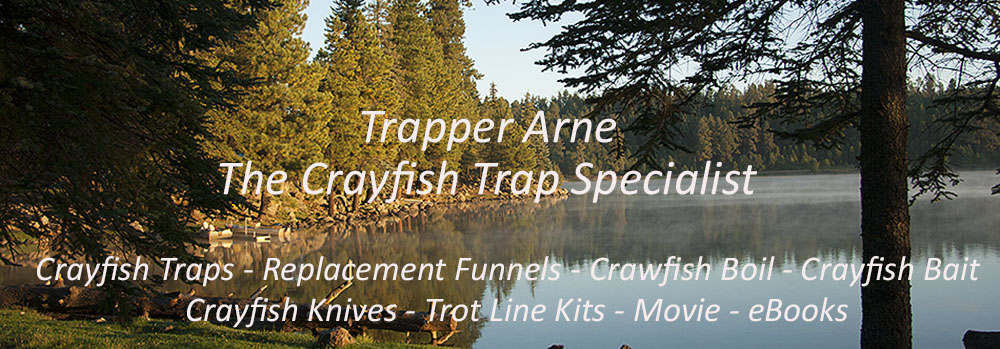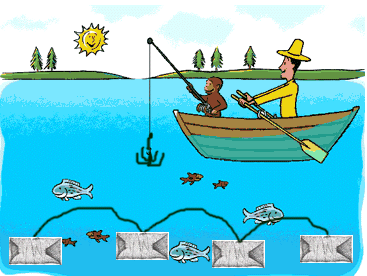
CATCH MORE CRAYFISH WITH TRAPS FROM TRAPPER ARNE
CATCHING CRAYFISH USING TROT LINES
My first experience with trot lines for catching crayfish was dismal. Now, in retrospect, I almost find that first experience amusing. I did everything possibly wrong in this first attempt. After that disaster and because the single-trap-with-a-string-and-a-float method had worked so well for me, I really did not mind ignoring trot lines for a while.
One of the main advantages with trot lines is of course that the traps are kept hidden - under the water - with no floats showing long fingered and unscrupulous people where they are hiding. Even though I have never lost a trap to thievery, yet, I realized that it is probably a good idea to keep traps out of sight, especially in waters that are frequented with many other fishing people.
When putting out traps in lakes I have always been aware of the possibility of thieves, but I took precautions to minimize the risk of losing traps to lawless elements. Setting out traps during daytime hours, I made sure I was in the vicinity to keep an eye on them. When placing traps for a night catch, I set them out after it was too dark for fishermen to be out on the lake.
As I became more active in catching crayfish and as I started using more traps, I decided that I was probably playing a gambling game with people's honesty. After reading Terry Bullard's excellent treatise on the subject, I decided it was time for me to make another attempt at using a trot line when catching crayfish.
The principle I used during my first attempt at trot lines was good. But the execution of it was lousy. For one thing, I was not using a floating line. This is most important, or you will, as I did, get the sinking line entangled in all sorts of debris on the bottom of the lake. Second, the trot line should be rather sturdy; at least 1/4" thick is recommended. Initially I had used much skinnier line.
The rope, polypropylene cord which floats, must be wound some way, maybe on a cranked reel, to keep it out of the way from gear in or around the boat. Each trap should have a clip that can be fastened to the trot line at predetermined intervals. Arbitrarily I chose the distance of 20' between each trap.
Best is undoubtedly to keep all hooking clips on the trap, leaving the trot line free from encumbrances on the crank-up reel. When setting up for my second attempt at trot lines, I did not have the correct clips to fasten to my traps. So instead I made a loop on the trot line every twenty feet and attached a little clip there which could be attached to the trap. It worked, but leaving the trot line free of this clutter would be better.
My second serious attempt at trot lines was limited to 5 traps. Simply because Wal-Mart that day did not have any other lengths than 100' poly in stock. What I wanted was a trot line for at least ten traps. Learning to crawl before walking made me accept this limitation. As I usually go crayfish catching with at least ten traps, I should have a trot line that is at least 200-300 feet long. As I am not catching crayfish commercially, I doubt I will want to have any longer trot lines. Professionals lay out lines that hold many more traps. But they also have sturdier equipment, larger boats and heavier traps that put up with rough treatment.
The cranked reel I wanted to install for my little row boat was another problem. Before I committed myself to any large expense, I decided to use whatever I could find in my garage and around the work bench. A metal stake for holding a real estate For Sale sign became the crank, after some hammering, bending and sawing to make it fit. Fit what? A heavy duty plastic milk carton crate that the nearest thrift store sold me for a dollar. The crank shaft fit just right between each side and reached into the side holes as if they had been made for my crank.
With a small hose clamp on the crank shaft, I fastened the poly line and started cranking it in. It worked! Then with a loop on the poly line every 20 feet and I was practically in business. As all my traps will be equipped with easy-open clips, they will easily clip onto the rope as I crank out the rope into the lake.
In the crude drawing here you can see how the traps and the rope ideally look at
the bottom of the lake. As the poly rope is buoyant, it will float free from the
bottom, minimizing the risk of tangling with rocks and other debris.

I have now discontinued my crank trot line in favor of a simpler method. I simply use a round plastic container into which I twirl the trot line with clips spaced every 20 feet or so. As the traps come up from the lake, I hand twirl the poly line into the container until the trap with the clip comes up. I then disconnect the clip from the trap and fasten the clip to the edge of the container. And then on to the next trap. As the trot line enters the container in an orderly fashion, it will be ready to go the opposite way when it's time for setting out traps again.
Go to VIDEOS to see the video about how I make and use trot lines.
But if you have no float bobbing in the water, how do you find the trot line with all its traps? Important question, and here is how. Either you fabricate your own grappling hook with junk from under your work bench like I did, or you buy one in some fishing gear store. My very first grappling hook was actually made from a couple of wire clothes hangers. (The picture shows just about how my first grappling hook looked.) I had lost a trap one day, but with the help of this hanger contraption I was able to retrieve it again.
When setting out traps using a trot line without floats, you must make sure to find a landmark on the shore where your traps are placed. This is mandatory, or you may not find your submerged traps. Looking at the drawing of traps on a trot line, you will see that the rope is floating and standing free of the bottom between the traps. Pulling your grappling hook across the area of the submerged traps and trot line, you can now hook the floating rope.
You can actually have a trot line with only one trap. In order to have something to grapple on, leave a length of floating cord on one side of the trap with a weight at one end.
Here is another very important difference between individual trap floats and traps on a trot line. With floats you have to determine the maximum depth for the trap by deciding the length of the float string. If you drop a trap deeper than the float string, you'll see the float slowly but surely disappear under the surface. With trot lines you really don't care. You'll find the trap line with the grapple no matter how deep it is - within reason, of course. As my float strings have usually been only ten feet, I really have not had a chance to find crayfish that spend their lives deeper than that.
If you don't like the completely submerged string of trot line which you have to locate with a grapple, there is another solution. Leaving one end of the trot line from the last trap long enough, you may let it reach the shore and anchor it in an inconspicuous way so no one will find it. Except You! I have often used an inconspicuously dark colored plastic float at the end of the trot line which I can easily find, but which is hard for others to see. But, with either method, make sure you have a good landmark on the shore line to come back to when the traps are ready to be pulled.
Back to top of Page
Back to HOME Page
